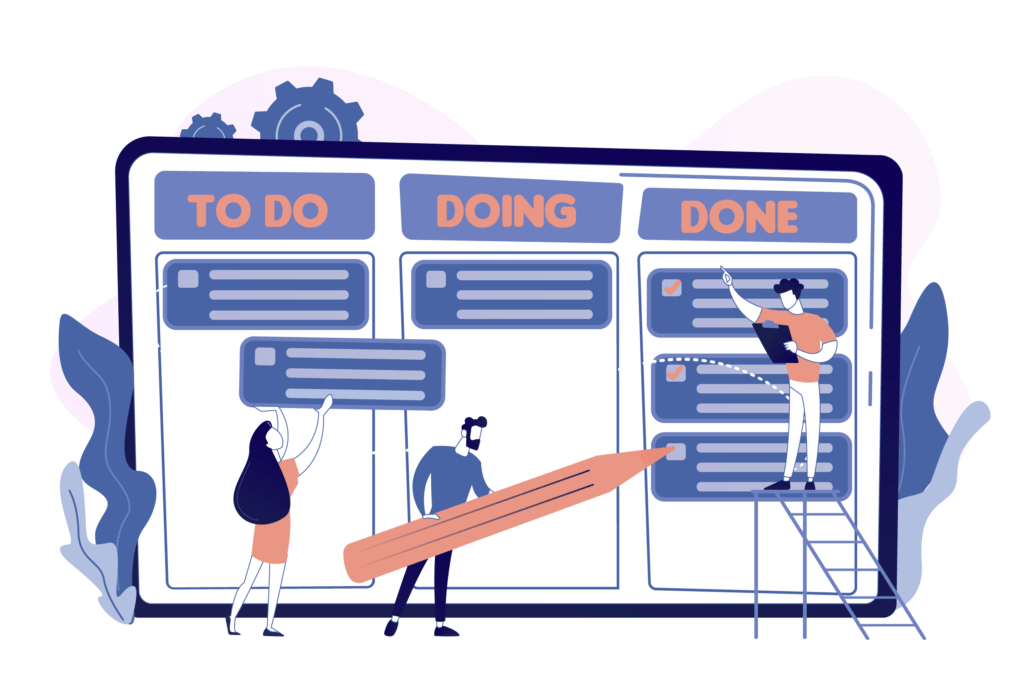One of the first things you need to do before starting a new project is decide what type of management system you’ll use. A choice that has been growing in popularity with all kinds of modern businesses over the last decade or so is agile project management. It’s ideal if you want to be able to adapt quickly as your requirements change.
What Is Agile Project Management?
The agile project management methodology was born in 2001 with the Agile Manifesto. Although the manifesto originally applied just for software development, it has turned out to be effective for virtually every industry.
Basically, agile project management involves splitting a project into smaller tasks and spreading these out over iterations. At the end of each iteration, you test your product. The approach of completing just sections of a project at a time allows your team to navigate uncertainty and be more innovative.
The signatories of the Agile Manifesto also stated four core values to implement their approach:
- Individuals and interactions over processes and tools. As much as developing processes and using tools can help in your project, the emphasis always needs to be on people. This applies even when developing products is complex, since it’s only through human input that you’ll be able to adapt to new challenges.
- Working software over comprehensive documentation. Although this value refers specifically to software, it could equally apply to any type of product. The point is you should avoid spending many weeks writing up a plan; instead, you need to figure out what information your team needs to start development.
- Customer collaboration over contract negotiation. By involving customers in the process, you ensure the finished result meets their needs.
- Responding to change over following a plan. Instead of worrying about the expense of heading in a different direction, you need to see a deviation from your plan as a way to increase your chances of success.
The Agile Project Management Principles
Another part of the Agile Manifesto are the 12 principles. Again, these were originally for software, but today businesses of all types use them to adapt the agile project management process to meet their own needs.
1. Early and Continuous Delivery
Your highest priority should be to satisfy customers. This means delivering a product early to gain feedback and then continuing to provide updates that add something of value for the customer. Using a minimum viable product allows you to achieve this.
2. Welcome Changing Requirements
Throughout the project (even at the late stages), you need to embrace change. It may be frustrating that your previous work ends up having no value, but this is ultimately the only way to ensure your finished product is relevant and meets customers’ needs. It is this that will give you a competitive advantage.
3. Deliver Frequently
The third principle is almost a throwback to the first. However, it adds an important caveat: in addition to delivering an updated product continuously, deliver it frequently. In fact, the manifesto clarifies that frequently means at least every couple months, preferably every couple weeks.
4. Work Together Daily
Everyone on your team — those involved in the business side as well as those in product development — must collaborate on a daily basis. This should continue throughout the project.
5. Motivated Individuals at the Center
Whether your team is made up of employees or outsourced professionals, these individuals need to be at the center of every project — and they need to be motivated. You must be able to the people on your team and provide them with the freedom to pursue innovation.
6. Face-to-Face Conversation
The world has changed plenty since 2001. It is no longer necessary to meet in person to have a face-to-face conversation — in fact, this only limits who can be on your team. However, the point that you need to see individuals’ facial expressions and body language remains important. Therefore, whenever possible, opt for video conferencing over voice or text chats.
7. Measure Progress with Working Software
To make this principle relevant for businesses producing something other than software, simply change it to “a working product.” In other words, mockups and models have little meaning until they become actual products customers can use.
8. Sustainable Development
Principle five was about a motivated team — we return to that idea in principle eight. An agile project may take a long time to complete; it’s critical you avoid an uneven workload for your team. Sustainable development means progressing at a constant rate throughout the project to ensure everyone stays motivated.
9. Focus on Technical Excellence and Design
It can be tempting to do whatever possible to get your product to market as soon as possible. However, neglecting design for too long eventually slows you down and makes you less agile. Counterintuitively, then, neglecting your design to concentrate on its release can actually delay your entry to market.
10. Simplicity Is Essential
The Agile Manifesto defines simplicity as “the art of maximizing the amount of work not done.” There are many ways you can apply this; for instance, you can seek processes to eliminate, find ways to automate, and delegate admin tasks that are a waste of your time.
11. Self-Organizing Team
This penultimate principle is all about allowing team members to take the lead and avoiding micromanagement. It ties into a number of other principles, especially those related to motivation and innovation.
12. Regular Reflection
Lastly, your entire team needs to come together often to reflect on how you can be more effective and to create an action plan to put your ideas into practice. This principle applies even if your team has worked together on many projects in the past — after all, there’s always room for improvement.
Agile vs Waterfall Project Management
An alternative to agile is waterfall project management — the traditional way of managing projects. It’s a good idea to weigh the pros and cons of agile vs traditional project management to ensure you choose the right option for you.
What Is Waterfall (or Traditional) Project Management?
Traditional project management uses a linear approach with stages like analysis, design, implementation, testing, and maintenance (although the names of the stages differ from company to company). You decide on the steps you’ll take before you begin the project and figure out a budget, timeline, and scope up front.
If you’re working on a project that’s similar to one you had in the past (and requirements have not changed), this can be effective. You already know what tools you’ll need, what challenges you can expect to face and how to resolve them, and what kind of talent you need on your team.
There are several advantages to this method:
- It works well with large-scale projects.
- It involves minimal input from clients.
- You know what the project will require from the start.
However, it also incurs some major risk:
- You only test the product at the end of the project.
- It’s expensive if you need to restart.
- There’s no chance to gain ongoing input from customers.
- It’s difficult to adapt.
- This style is inappropriate for complex projects, particularly if you’ve never undertaken anything similar in the past.
Benefits of Agile Project Management
In contrast to the above, there are no set agile project management steps. This the reason why agile is becoming almost the default choice in many industries and why it leads to a number of advantages, including:
- More predictable results
- Greater control over your project
- Less risk
- A higher-quality product
- Greater satisfaction from customers
- Flexibility throughout the project
- An engaged team
- A better understanding of your customers
Disadvantages of Agile Project Management
All this isn’t to say that agile project management is perfect. There are a few downsides to consider as well:
- It’s difficult to set an accurate timeline and budget
- There’s a need for high customer involvement, which can be unfeasible or customers may be unwilling
- Projects require dedication from everyone on the team
- It’s more suitable for small and medium-size projects than large undertakings
Best Agile Project Management Tools
If you do opt for the agile approach, you’ll find it much easier if you use tools or software. There’s a wide range to choose from, including both paid and free agile project management tools.
Asana
A top piece of agile project management software is Asana. It’s user friendly, you can customize the presentation of tasks, and it’s easy to categorize, delegate, and prioritize activities. Plus, there’s no need to delete finished tasks — you can just mark them as complete to keep them on record or use to create duplicates.
Price: Free for Basic, from $10.99 for Premium per month
GitHub
If your project involves coding, GitHub is essential. You can store all your code to work with others and revert to old versions if needed. Furthermore, if you need help with your code, you can find support in the GitHub community.
Price: Free for the basics, from $4 per user per month for Team
Forecast
Developers seem to speak different languages than those handling the business side of the project. Since one of the principles of agile project management is making sure these two groups work together on a daily basis, a tool to assist with this collaboration can be hugely beneficial. Forecast allows you to continue using terminology you’re comfortable with, but it communicates progress in terms everyone can understand.
Price: Starting at $29 per month per user
Managing projects can take up a huge amount of your time — even when you do adhere to the agile principles. Delegating is critical to keep your team on track. A virtual assistant can take over many of your project management tasks, including team wrangling, monitoring progress, budgeting, and analysis. Right now, readers of the MYVA360 blog can receive a 10-percent discount on our VA services. Schedule a consultation to claim your discount.






